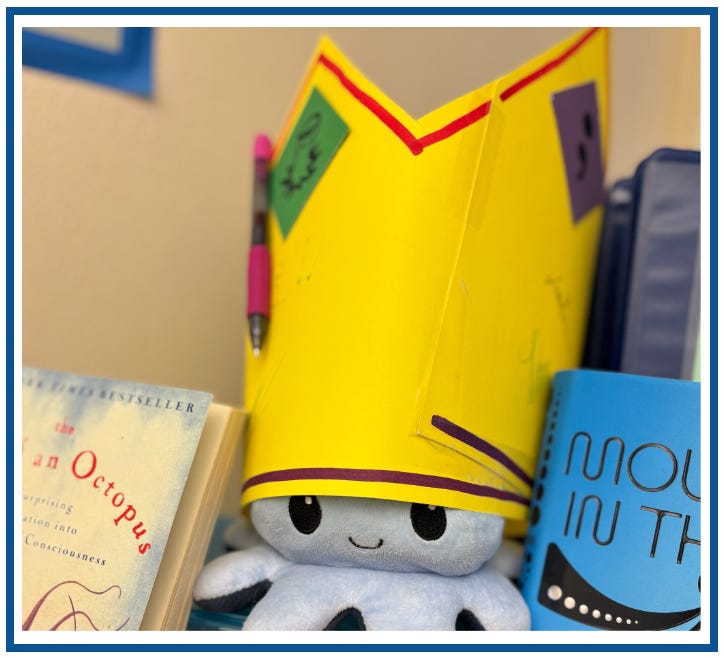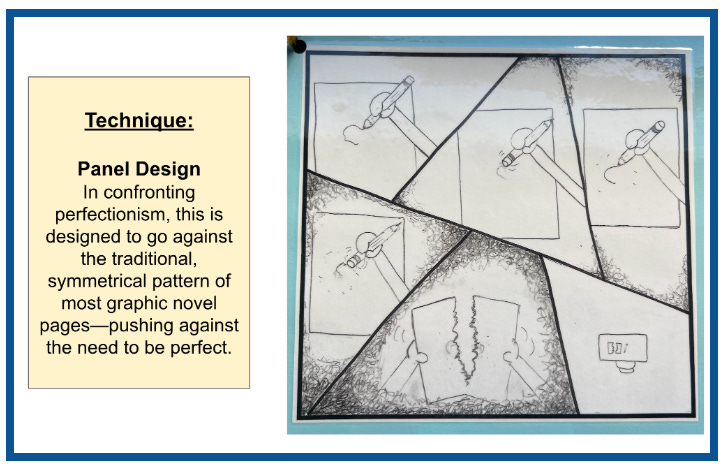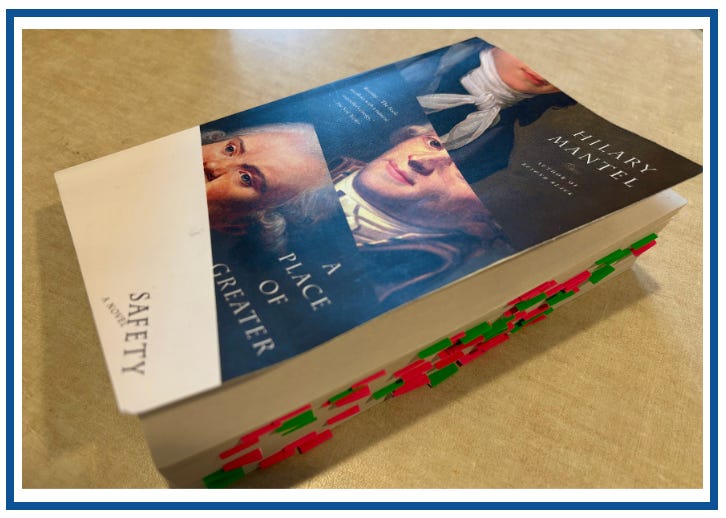Uplifting Moves in the Classroom
why they matter for students—and for you as a teacher, too
“Okay everyone, I have something to show you.”
In the middle of a rather-dull lesson earlier this year, I reach above a filing cabinet and pull out my hastily-designed “classroom crown”—which I cut out of yellow cardstock paper each year and assemble as part of my last-minute preparations.
“See this?” I ask, holding it aloft. “If you win, you get to sign the crown.”
I then change my tone a bit and gesture to another wall, where crowns full of signatures of former students have been untaped and stapled to a bulletin board.
“Your name can live forever in this classroom,” I say, gesturing to the front of the room.
Students look: all signature-filled cardstock crowns from previous years are indeed featured prominently on the front wall.
“Everyone ready?”
Almost immediately, the energy changes in the room as we go into our textual evidence review activity—Seriously! I’m not kidding!—and ten minutes later one quite-excited group is one of the first this year to “sign the crown.”
Lots of laughter, but also some proud smiles from that group.
All from a piece of yellow cardstock paper assembled just before the school year began.
Why I’m Writing This Post, This Week
Every so often, you have one of those weeks as a teacher that sort of leaves you spinning in all directions. When it rains it pours, so to speak—inside the classroom and outside of it.
This week was without question one of those weeks for me, one that left me trudging out of the building most days.
Yet I’m also reminding myself as this week comes to a close (finally!) that I do not want the heaviness to beget more heaviness.
Sometimes I feel like teaching can weigh us down in a way that prevents us from accessing and centering what is good. Which in turn leads to it weighing us down even more.
This is why I so appreciated the chance to talk with Adrian Niebauer about the shared heaviness of the year, too—as the very act of having conversations with others in this work is one of the ways we can push back, I think and choose hopefulness instead.
Building on that conversation with , I wanted to briefly share four different “moves” I use from time-to-time in the classroom with the express intention of uplifting students.
Of pushing back against that heaviness that sometimes settles in the classroom.
4 Moves for Uplifting in the Classroom
So here we go: four different strategies I use from time to time, and especially during heavier times, to try and uplift students in the classroom (Update! If you want to watch a conversation in which I talk more about what these moves look and feel like, check out this newly-published video by ):
⓵ “Everyone—write down what _____ said!”
This is one of my absolute favorite moves in the middle of a lesson, especially when students already have highlighters in-hand as we close-read a text.
All it takes? If a student says something that (a) surprises/impresses you in a genuine way and (b) could elevate the thinking of their classmates, ask them if they can repeat it.
Then before they repeat it, you say the magic words: “Everyone else grab your pencils and write down exactly what _____ says—we all need this on our papers.” (Note: you can even add it to your own notes enthusiastically to hammer home the intention.)
Why I love this move? It is a fantastic opportunity to not just celebrate but reaffirm the voice and perspective of a student in a tangible way by literally having their classmates write it down.
Really simple. Really effective.
⓶ Kneel down, give quiet praise (but not too quiet)
Sort of the opposite of the first move, this is one that I tend to use especially once I get to know students more—as sometimes it is the opposite student who benefits from this compared to the first.
If anyone has been in my classroom, you’ll likely see me popping all over and kneeling down to desk level for individual conversations and support (with increasingly-creaky knees!), so within that existing routine I then sometimes take it one step further to simply name to a student how well they are doing.
“Really quickly,” I’ll say, “I just want you to know you have had a really awesome stretch in the classroom lately.”
Usually this is done at almost a whisper, but I’m also aware that they are aware that other students can hear it. So simultaneously I’m avoiding a whole-class public praise but still celebrating them aloud in a way that they know at least those seated around them can hear.
Why I love this move? While I do love the “write them a note” strategy for this type of quieter student, this “loud whisper” move is much quicker and can just as readily build rapport, leaving the student feeling seen for how well they are doing.
⓷ Ask if you can take a picture, use it as an example
As I shared a month ago with ’s The Cult of Pedagogy, I continue to be a huge fan of finding ways to center the work of students in the classroom. With student writing, I frequently showcase anonymous high-quality and innovative exemplars—with the added benefit that the student who wrote it knows that their own work is being affirmed in front of the entire classroom.
However, the downside of showcasing anonymous examples is that it removes the opportunity for the request to share those examples.
Seriously: sometimes a student’s entire body reacts when you walk over, take a look at their work, and then kindly ask, “Can I take a picture of this to use as an example for others?”
The question really does the work by itself.
Why I love this move? This move puts the ball in the student’s court in deciding if they’d like to share it or not—and it can also be a written note on a returned assignment (see example of a written request at the beginning of this section).
Just like the first move, too, I think the praise lands more substantively when you attach it to the rationale that their work is high-enough quality that you want to use it to help support their peers as well as potential future students.
⓸ “Who can I brag to about how well you’re doing?”
I’m a big fan of the quick, positive note home to student families whenever possible as a teacher—especially at the beginning of the school year, too, when you are trying to pull every lever you can to build a foundation of rapport within your classroom. (And yes, this was a lever-pulling week in our classroom, without question!)
However, like the previous move, by making a slight tweak this becomes a double-affirmation: [1] you get to have the conversation where you tell the student that you want to brag on them to someone else and [2] you get to follow through by bragging on the student in the direction they choose.
Their coach. Another teacher. A sibling at the school. A different family member. The principal. A club advisor. Maybe even a classmate. (Really: it happens!)
You ask them, they tell you, then you pick up the phone and call. Just like that!
Why I love this move? Along with the double-win in framing it as a question, you also walk away with a bit more of an understanding of who the student values enough to have that brag sent in their direction.
More importantly, though, there is genuine rapport that comes from following through with one of these—the type of rapport you can build a classroom upon.
You See What You Look For
Even amidst a pretty challenging week in the classroom, at the end of each day I took a moment to pause and consider what a small win was before turning off the lights and heading out.
Though I have my new October calendar for writing down a win each day pictured above, I now have my September calendar with every day filled posted near my desk—a month full of wins from good days, yes, but also wins from very-hard days. Now in my second year of doing this, I realize there are few pieces of paper more important than this one in my classroom right now.
Because it keeps me focused on the stuff that keeps my cup filled.
I think intentional strategies to uplift students in the classroom are like this, too, as incorporating these “uplift moves” as a teacher isn’t just about the tools and strategies but rather the perspective they insist upon with them: that you constantly are on the lookout for ways your students deserve to be celebrated.
Talk about a perspective worth holding onto, right?
Before Signing Off, One Last Uplift
I recently finished reading A Place of Greater Safety by Hilary Mantel, my second year of taking a slow-read journey with ’s after moving through a daily read of Tolstoy’s War and Peace in 2024.
I cannot adequately capture how much these slow-reading experiences have meant to me, particularly as a teacher who very much values the “learner hat.” To not just read some heavy, important texts with thoughtful guidance each step of the way but to find community while doing so? What a gift that has been. (I never would have imagined myself at one point talking Tolstoy on a Zoom call with folks from 10 different countries!)
Consequently, I cannot recommend enough checking out Simon’s slow-reading journeys for yourself. To read in community is without question one of the things I love most within the classroom, which I think is why I have found so much value in doing so outside of it, too. So I wanted to take time to uplift this incredible experience to our readers before signing off this post.
And finally (you knew this question was coming!) what are the ways you uplift students in your classroom or context? Do you have specific moves or strategies? Feel free to share in the comments, as I’m sure there are myriad more out there!







Goodness, I love all of these. One of my favorites (which really is a sub-point of #2 or #4) is noticing when kids try something new or practice courage. For quiet kids, I'll say something like, "I noticed you spoke up today. That was brave. I'm really proud of you." This essay is just gold.
These are all so simple, and the impact so great. You care about them, know who they are, and notice them. Amazing. And I would bet that it lifts your heaviness too…